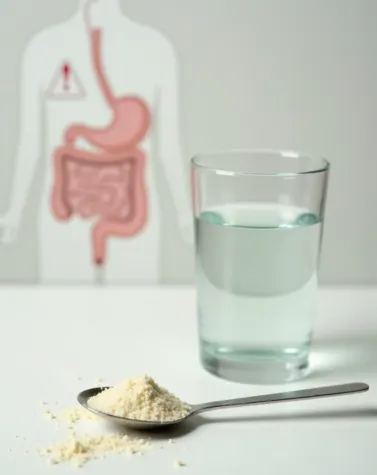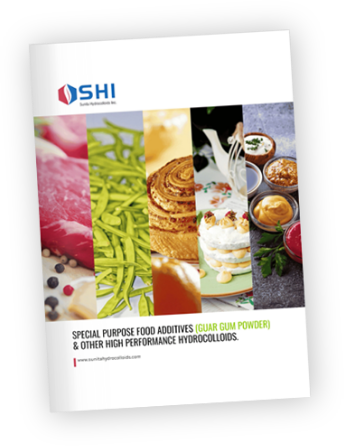
How Guar Gum Improves Oral Suspensions and Tablet Binding
Pharmaceutical excipients, also called inactive ingredients, are vital parts of drug formulas. They help the manufacturing process and also influence the stability, bioavailability and overall effectiveness of the active pharmaceutical ingredient (API). Guar gum is a natural hydrocolloid that has become popular because it is a cost effective non-toxic replacement for synthetic polymers.
Guar gum is a polysaccharide. It has a linear backbone of mannose units linked by (1,4)-glycosidic bonds. It has side chains of single galactose units attached to every second mannose unit via glycosidic linkages. This specific mannose to galactose ratio (about 2:1) makes it hydrate quickly and have a high viscosity even at low concentrations. The US Food and Drug Administration (FDA) has recognized guar gum as a “Generally Recognized As Safe” (GRAS) substance for use in food and pharmaceutical applications. Formulators choose it because it is safe and natural.
Guar Gum as a Suspending Agent in Oral Suspensions
Oral suspensions are liquid formulas with insoluble solid drug particles. The particles are dispersed in a liquid vehicle. The main problem with suspensions is preventing the particles from settling over time, a process known as sedimentation. This can lead to an inconsistent dose and poor patient results. A suspending agent is a key to keeping a uniform dispersion.
How It Works
Guar gum works as a suspending agent by making the liquid vehicle thicker. Stokes’ Law explains this. It describes the settling velocity (v) of a particle in a fluid.
v = d2g(ρp − ρf) / (18 μ)
In this formula:
- v is the settling velocity of the particle
- g is the acceleration of gravity
- ρp is the density of the particle
- ρf is the density of the fluid
- d is the diameter of the particle
- μ is the viscosity of the fluid
As you can see from the formula the settling velocity (v) is inversely proportional to the viscosity of the fluid (μ). By creating a thick gel like matrix in water guar gum greatly increases the fluid’s viscosity. This dramatically slows the settling velocity of the drug particles and keeps them suspended for a long time. The shear thinning nature of guar gum solutions is also helpful. When a user shakes the suspension the viscosity temporarily goes down. This makes it easier to pour and give a dose. When the shear force is removed the viscosity quickly comes back stabilizing the suspension again.
Advantages in Suspensions
- Dose Uniformity: Guar gum prevents sedimentation. This ensures each dose has the correct amount of the API. This is important for therapeutic consistency and patient safety especially for children and older people.
- Enhanced Stability: It stabilizes the formula by stopping flocculation and caking. These problems can’t be reversed and make a product unusable.
- Improved Patient Acceptability: Guar gum creates a smooth non-gritty texture. This can improve how a suspension feels in the mouth and lead to better patient acceptance.
Guar Gum as a Binder in Tablet Formulations
Tablet compression is a basic process in making pharmaceuticals. Binders are added to ensure that the granulated powder particles stick together under pressure to make a compact durable tablet. Guar gum is widely used for this because it is a great binder.
How It Binds
Guar gum is a binder that makes powder particles stick together during the granulation and compression phases. Its high molecular weight and linear structure allow for strong bonds with other excipients and the API. As a wet binder the guar gum solution forms liquid bridges that become solid upon drying. This makes strong granules. As a dry binder its cohesive properties make it bind particles together during the direct compression process.
The binding power of guar gum is directly related to its concentration. Higher concentrations often result in:
- Increased Tablet Hardness: The tablet’s ability to resist breaking is improved.
- Reduced Friability: A tablet’s tendency to chip or crumble during handling packaging and transport is much lower.
Guar Gum’s Dual Function: Binding and Release Control
A key benefit of guar gum is its ability to do more than one thing. It is an effective binder but it can also play a major role in controlling drug release. At higher concentrations guar gum creates a hydrophilic gel matrix when it touches gastric fluid. This gel layer swells and slows the drug’s diffusion from the tablet. This makes it a great choice for sustained or controlled release formulas. This is particularly useful for drugs that have a short half-life or need a consistent blood plasma level. On the other hand at lower concentrations it can also work as a disintegrant. It swells quickly when it hydrates which makes the tablet break apart. This leads to a faster drug dissolution and absorption.
Advantages and Limitations in Pharmaceutical Applications
Advantages
- Natural and Biocompatible: As a natural polymer it is not toxic and is biodegradable.
- Cost Effective: It is much more affordable than many synthetic replacements like xanthan gum or HPMC.
- Dual Function: It can be a binder, a suspending agent, a disintegrant and a matrix former for controlled release.
- Cold Water Soluble: It can hydrate and thicken in cold water which makes the manufacturing process simpler because it does not need to be heated.
Limitations
- Microbial Contamination: Because it’s a natural product it can be subject to microbial breakdown. This means you need to use preservatives in liquid formulas.
- Viscosity Stability: Extreme pH and temperature can change its viscosity. This may limit its use in some formulas. However chemical changes can help with this problem.
- Batch to Batch Variation: As a natural product there can be small changes in quality and viscosity between different batches. This requires strict quality control.
Our Expertise at Your Service
At Sunita Hydrocolloids Inc. (SHI), we know how important high quality guar gum is for pharmaceutical use. Our SUNCOL GRADES of native guar gum powder are available in different mesh sizes and viscosity levels. They are made to meet strict quality standards. From very high viscosity powders like SUNCOL-207 (7000-7500 cps) for strong suspension stabilization to medium viscosity powders like SUNCOL-204 (3500-4500 cps) for a good balance of binding and flow properties our products are made to meet many different formula needs. We also have purified and depolymerized grades like SUNCOL-P 500 and the SUNCOL-DP series. These are for specific needs like a lower microbial load or controlled viscosity. Our dedication to quality and custom made products ensures you have the right hydrocolloid for your use. We help you create safe, effective and stable pharmaceutical products.
Explore More on Guar Gum in Pharma
Looking to deepen your understanding of guar gum’s role in pharmaceutical and industrial applications? Check out these related insights:
- Guar Gum in Pharmaceutical Formulations
Learn how guar gum contributes to drug stability, bioavailability, and formulation efficiency across various dosage forms. - What Is Guar Gum?
A comprehensive overview of guar gum’s origin, properties, and uses in food, pharma, and industrial sectors. - Guar Gum vs Xanthan Gum: Which Is Better for Your Formulation?
Compare the functional differences between guar gum and xanthan gum to choose the right hydrocolloid for your needs.





